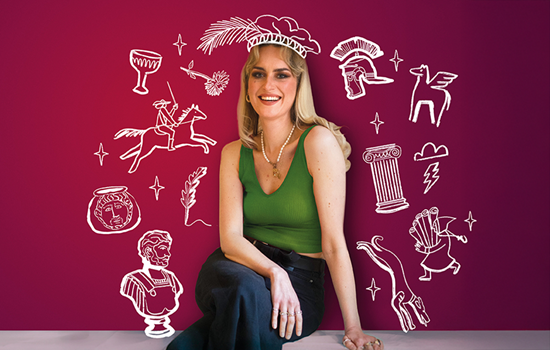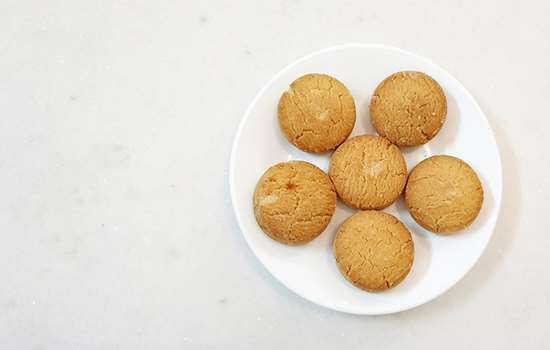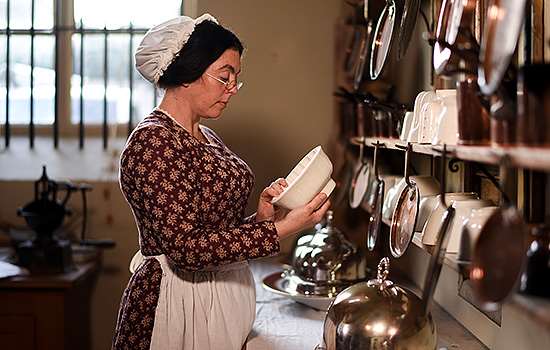How to Make Victorian Ice Cream
A popular frozen dessert that we might take for granted nowadays was much more time-consuming to produce for the Victorians. But that didn't stop some entrepreneurial cooks from becoming experts in ice cream and ices, even without electric appliances to hand.
Join Mrs Crocombe as she whips up a batch of a rather unusual (but delicious) flavoured ice cream in the kitchens of Audley End House in Essex.
Words by Dr Annie Gray
Cucumber Ice Cream
The idea of cucumber ice cream may strike you as unusual, but the Victorians enjoyed a wide range of flavours, and were often far more imaginative with their ingredients than we are today. Cooked cucumber was a popular side dish, and it’s cool and refreshing taste was the perfect way to round off a hot summer’s dinner party.
Cucumber Ice Cream is a very simple recipe – puréed cooked cucumber, sugar, ginger brandy (or wine), lemon juice, and sweetened cream or custard. The addition of green food colouring is typical of the late Victorian period, when chemical dyes and artificial flavourings were opening up a world of exciting short-cut options for the busy cook.
The Queen of Ices
The recipe we demonstrate in the video above comes from Agnes Marshall's The Book of Ices (1885). As queen of Victorian Ices, Agnes was a fantastic entrepreneur, selling books, equipment and teaching lessons on how best to make and mould ice cream. She also travelled across Britain lecturing, and published two general cookery books. Her two ice cream books contain some of the best recipes for ices you will ever come across – yet sadly, she’s virtually forgotten today.
Agnes Marshall patented a zinc-lined machine which promised to freeze ice cream in just 3 minutes! Around the central pewter jar the cook would put a mix of ice and salt. The salt lowers the temperature of the ice, and depending on how much salt is added, it can get to as low as -20 degrees centigrade – sometimes even lower. When the mixture is churned, it quickly freezes and can be put into a mould. The Victorian cook would then have used an ice cave – a metal box in a wooden chest filled with more ice and salt – to freeze the moulded ice solid.
Agnes Marshall’s The Book of Ices is available as a modern reprint, called Ices and Ice Creams.
Keeping cool
The Victorians didn’t have access to electric freezers or ice cream machines. Instead they would have collected ice from rivers and ponds in the winter, and stored it in ice houses. Many large country houses had one, including Kenwood, Audley End House, Osborne and Battle Abbey. There were also commercial ice houses, stocking ice from Newfoundland and Alaska.
Ice houses were very simple - a huge well - often 40 feet deep or more, into which ice was tightly packed. A drain at the bottom would let any melted water out into the surrounding soil or back into the pond. At the top would be a small building, often resembling a brick igloo, designed to allow access but keep out the heat. Ice could be kept for years without melting. When it was needed, it would be hacked out of the well, and crushed up for use in the kitchens.
Frozen Desserts
Ices can be classified into three types – cream ice, water ice and sorbet. Cream ice was custard or sweetened cream, mixed with flavourings; water ice was sweetened water mixed with flavourings; and sorbets always contained alcohol. Sorbets were popular as courses in their own right during elaborate meals, as well as for a quick pick-me-up at a ball. Both cream and water ices tended to be served as part of the dessert course, which in a Victorian meal came after the fruit tarts, puddings and cakes we associate with dessert today. These consisted of fruit and nuts along with wine biscuits and ices, and acted as more of a palate cleanser than a filler, with an emphasis on elegance and beauty. Many ices were moulded and highly decorated, to please the eye as much as the palate.
Our Victorian cook is using a hand-cranked ice cream machine, a relatively modern invention in late Victorian England. From the introduction of ice cream to Britain in the 17th century to the 1930s, most people made ice cream with a simple sorbetière (a lidded pewter jar) in a wooden bucket. This would have been spun round by hand and occasionally opened and scraped down and mixed. It was much less labour-intensive than the hand-cranked machine, but it took longer. If you fancy trying this at home, you can replicate your own Victorian ice cream maker using a large bowl full of crushed ice and salt, and a metal lidded container for the ice cream – a tea caddy or small biscuit tin is ideal. You could even use a very strong plastic bag.
More to Explore
-

The English Heritage Podcast
Join presenter Amy Matthews on a journey through history, as we bring you entertaining tales from unexpected places.
-

The History of the Biscuit
Settle down with a cup of tea and treat yourself to the fascinating history behind the humble biscuit, from the Roman rusk to Victorian Petits Fours.
-

Victorian Cookery Recipes
Watch Victorian recipes being brought to life, and discover the reality of life below stairs at a Victorian country house.
-

BECOME A MEMBER
An English Heritage membership offers an unlimited annual pass to over 400 historic sites across the country plus free entry for up to six children.